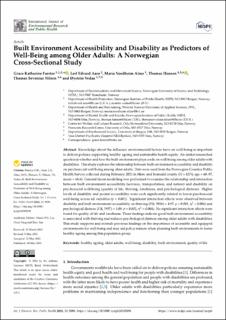| dc.contributor.author | Forster, Grace Katharine | |
| dc.contributor.author | Aarø, Leif Edvard | |
| dc.contributor.author | Alme, Maria Nordheim | |
| dc.contributor.author | Hansen, Thomas | |
| dc.contributor.author | Nilsen, Thomas Sevenius | |
| dc.contributor.author | Vedaa, Øystein | |
| dc.date.accessioned | 2023-05-24T11:28:17Z | |
| dc.date.available | 2023-05-24T11:28:17Z | |
| dc.date.created | 2023-05-20T13:12:38Z | |
| dc.date.issued | 2023-05-20 | |
| dc.identifier.issn | 1661-7827 | |
| dc.identifier.uri | https://hdl.handle.net/11250/3068826 | |
| dc.description.abstract | Knowledge about the influence environmental factors have on well-being is important to deliver policies supporting healthy ageing and sustainable health equity. An under-researched question is whether and how the built environment plays a role on well-being among older adults with disabilities. This study explores the relationship between built environment accessibility and disability on psychosocial well-being among older adults. Data were used from the Norwegian Counties Public Health Survey collected during February 2021 in Møre and Romsdal county (N = 8274; age = 60–97, mean = 68.6). General linear modelling was performed to examine the relationship and interaction between built environment accessibility (services, transportation, and nature) and disability on psychosocial well-being (quality of life, thriving, loneliness, and psychological distress). Higher levels of disability and poorer accessibility were each significantly related to lower psychosocial well-being across all variables (p < 0.001). Significant interaction effects were observed between disability and built environment accessibility on thriving (F(8, 5936) = 4.97, p < 0.001, η2 = 0.006) and psychological distress (F(8, 5957) = 3.09, p = 0.002, η2 = 0.004). No significant interaction effects were found for quality of life and loneliness. These findings indicate good built environment accessibility is associated with thriving and reduces psychological distress among older adults with disabilities. This study supports and extends previous findings on the importance of accessible and equipped environments for well-being and may aid policy makers when planning built environments to foster healthy ageing among this population group. | en_US |
| dc.language.iso | eng | en_US |
| dc.publisher | MDPI | en_US |
| dc.rights | Navngivelse 4.0 Internasjonal | * |
| dc.rights.uri | http://creativecommons.org/licenses/by/4.0/deed.no | * |
| dc.title | Built Environment Accessibility and Disability as Predictors of Well-Being among Older Adults: A Norwegian Cross-Sectional Study | en_US |
| dc.type | Journal article | en_US |
| dc.type | Peer reviewed | en_US |
| dc.description.version | publishedVersion | en_US |
| dc.rights.holder | Copyright 2023 the authors | en_US |
| dc.source.articlenumber | 5898 | en_US |
| cristin.ispublished | true | |
| cristin.fulltext | original | |
| cristin.qualitycode | 1 | |
| dc.identifier.doi | 10.3390/ijerph20105898 | |
| dc.identifier.cristin | 2148233 | |
| dc.source.journal | International Journal of Environmental Research and Public Health | en_US |
| dc.relation.project | Norges forskningsråd: 288083 | en_US |
| dc.identifier.citation | International Journal of Environmental Research and Public Health. 2023, 20 (10), 5898. | en_US |
| dc.source.volume | 20 | en_US |
| dc.source.issue | 10 | en_US |

